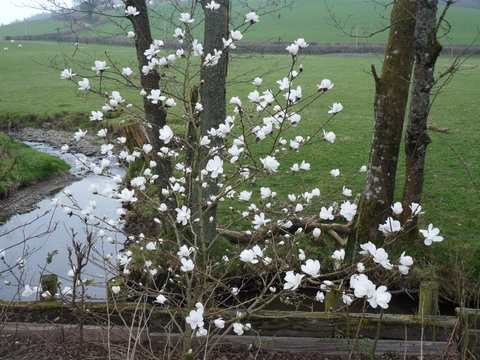No toads on the roads
Wednesday, March 30, 2011
Welcome Spring
After the excitement and mayhem of the frog spawning season last
month it has been eerily quiet in the Paddock Pond this month.
Normally March is the time for the toads to take over from where
the frogs left off but in spite of a mild month there have been but
a handful of toads in the pond. In previous years I have walked up
and down our lane picking up toads in bucketfuls to save them from
the cars and deposited them safely into the pond, many of them
clinging in rapturous embrace to their chosen partners! The winter
has certainly taken its toll and it is clear now that we have lost
all our golden rudd and most of the endemic pond life. In the last
few weeks however there have been a few pond skaters in evidence
which are always the first to colonise a pond
Weather report
A fabulous month! We thought February was good but March was
even better. Mild, little rain, plenty of sunshine and very few
frosts. Such a contrast with last year when March was more like
winter with heavy snow and severe night frosts. I am sure we will
get more cold spells before the Spring is out but it would be nice
for once not to get any late frosts. We live in hope!! Sadly one of
the few cloudy nights we had was when the moon was full and a large
moon was expected because of its closeness to the earth.Isn't that
just typical when hoping to see astronomical events!!
Garden update
The fine weather has permitted much activity in the garden. All
the dead perennial haulms have been cut back and, although this may
not be enviromentally sound, boy did we have some good fires as
everything was so dry. This is a 3 day job and so good to get it
finished in March. Few weeds in evidence thus far so border weeding
is moving on at pace.
Paddock Borders before "the chop"
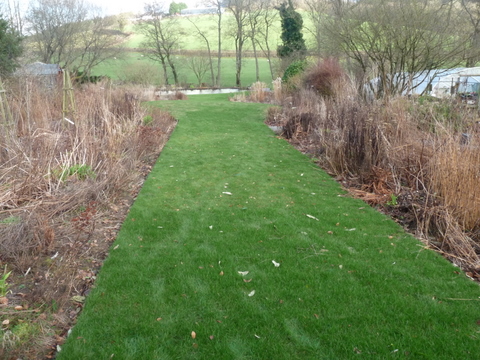
All vegetable beds were turned over last week and as the ground
is so dry and has warmed up we have planted all the early potatoes,
shallots and onions, and broad beans started in pots in the
polytunnel last month. We have also sown more broad beans for a
later harvest, peas, carrots, parsnips and beetroot under
fleece.
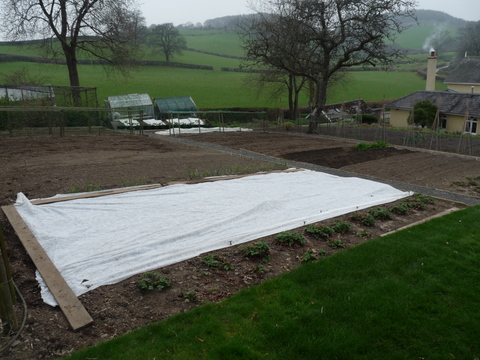
We made the first cut of the lawns in the second week of March
and the grass has greened up well. Only 8 months of lawn mowing
left, in some weeks up to 4 times a week! Just invested in a new
mower to make sure its up to the job - my old one has expired.
A major job has been re-potting and splitting all plants in the
nursery, most of which under cover of the cold frames have done
very well. All we have lost are the oriental poppies (as always).
some hollyhocks and most annoyingly some of the hemerocallis
hybrids I had as seed from the USA last year.
We have continued to sow more seeds in the propagation tunnel
and are now up to 250 varieties sown - I am nuts! Very good
germination all round and very little damping off which can often
be the scourge of seed sowing. The kind weather and the opportunity
to fully ventilate on most days has made a big difference. Only
need to prick them out, grow them on and finally pot them up and
they will be ready to plant out or to sell!!
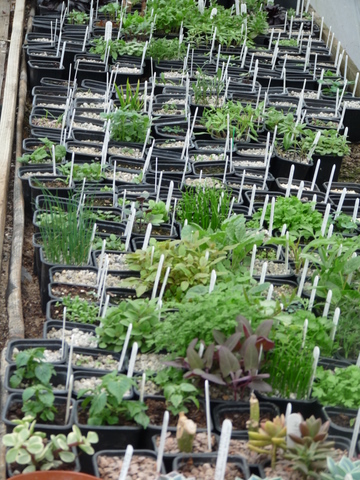
As if this wasn't enough I continue to look for plants to
propagate in the borders which are most requested by our visitors
in particular red astrantias, phlox and violas, and anything else
which has out grown its space or seeded around a bit too freely. I
have recently had plenty of seedlings of lunaria variegata alba, a
lovely from of honesty. I find it is best to leave them to seed
themselves in open ground and dig the seedlings up, rather than to
carefully sow the seed in the tunnel. Plants can be so fickle.
What's looking good?
I hate to say it again but this has been a fabulous year for
hellebores and they are continuing to flower like crazy. They do
have some serious competition now from a whole host of woodlanders
including anemone nemerosa in various forms, pulmonarias.
epimediums especially a form new to me e. grandiflora with
exceptionally large yellow flowers, and hacquettia epictatis in the
variegated form as well as the species all green form.
The narcissus tribe are well reperesented and are
dominated by the cyclamineus hybrid forms from Division 6 including
Jenny, Jetfire, Peeping Tom, Jumblie, Treena and Rapture (what a
great name for a fairly dwarf form fairly close to the true
cyclamineus species form even though somewhat larger).
Narcissus cyclamineus hybrid "Peeping Tom"
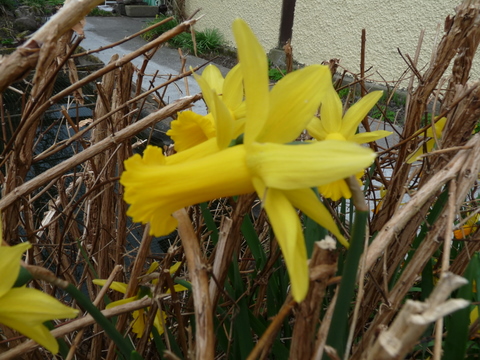
The large polytunnel looks good with lots of colour now
especially from clematis alpinas and macropetalla, brugmansia
sanguinea the red flowered form, euryops pectinatus a yellow daisy
family member from Mediterranean climates and the first of the
aquilegias.
Brugmansia sanguinea
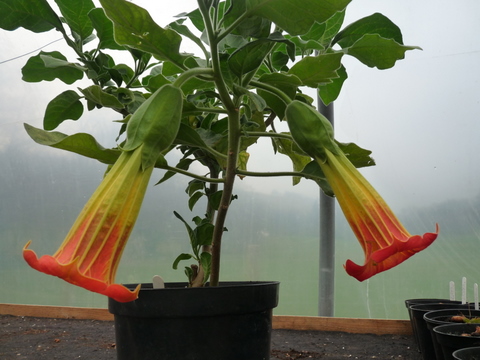
The vegetable garden is a delight to me: all cleared and ready
to grow it holds the promise of all the good things to come, the
fabulously fresh vegetables in great variety with all the health
giving properties, and the sheer joy of growing glorious food from
seed in just a few short months. No wonder that the talk on
Vegetable Growing I give to garden clubs has been so requested this
winter, So many peope are growing their own veg now. Such pleasure
and value in these hard economic times.
Wildlife
An amazing event this week. I keep a few mousetraps primed in
the polytunnels to stop mice and voles from eating seeds and
seedlings. I catch a few from time to time and a couple of days ago
after catching a mouse I threw the corpse into the field. I carried
on with chores in the nursery when I became aware of a red kite
overhead. It got closer and closer circling the field. It came so
close to me I could have almost touched it and saw its eyes and
beak in close up - they are seriously large birds! Ever quick in
the uptake it suddenly dawned on me that the kite had its eyes on
the mouse in the field. After a while I though it had lost interest
as it soared higher in the sky when suddenly it dropped like a
stone, picked up the mouse, flew off with it in its talons and ate
it in mid air. What a performance! They are incredible birds. After
this we have told Bojo our cat to watch his back!!
No summer bird visitors yet but they can't be far away if this
weather continues. For now we have marvellous displays of wild wood
anemones along the river and in the woods, opening their pure white
flowers on sunny days exhibiting all the joys of this wonderful
spring.
As more evidence of plants enjoying the early Spring:-
A lovely woodlander hacquetia eppactis
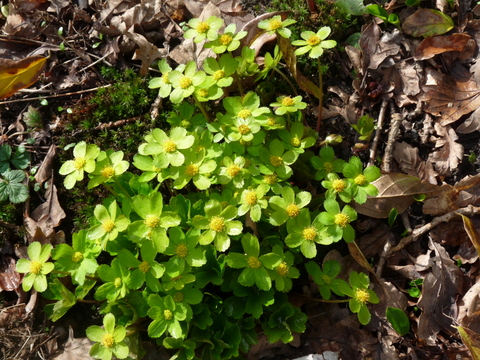
and another green flowered plant, an unusual form of primrose,
primula polyanthus "Francisca"
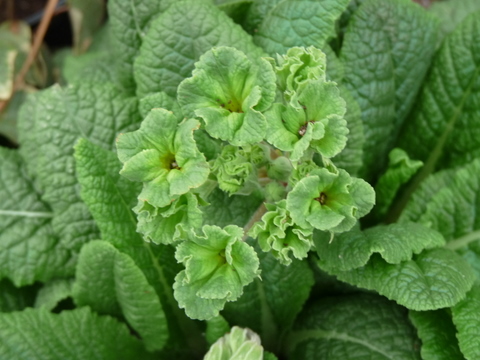
and this lovely hepatica having its best year in the woodland
garden
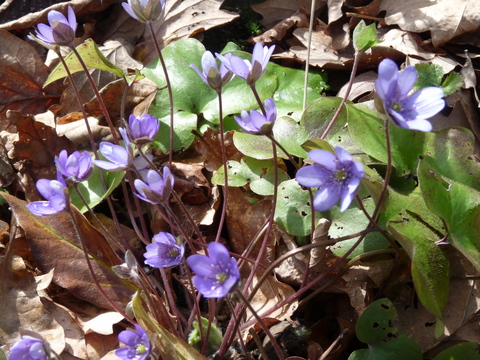
Frtillaria melleagris white form - very choice!
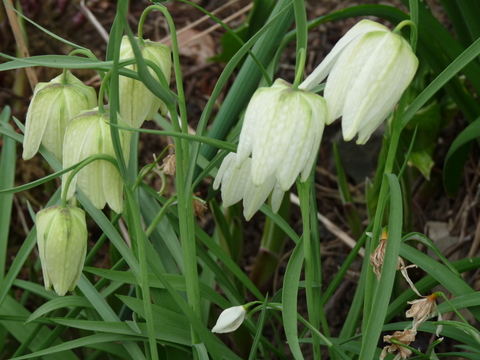
Visits
There have been 6 talks this month including I am pleased to
say, 2 on hellebores, at venues from Clunderwen in the west to
Llangynidr in the east. One more left in April before the season
comes to an end. Already have a good few talks booked for next
winter so if you would like us to deliver a talk to your club or
society, please don't hesitate to get in touch.
We had an excellent trip to Manchester earlier this month to see
the fantastic collection of species hellebores at Phedar Nursery,
Stockport. owned by Will McLewin. (www.phedar.com) He has
been an avid hellebore hunter all over Europe (especially to the
countries formerly being part of Yugoslavia) for more than 30
years in the quest of identifying all the various forms of
hellebores in the wild and to bring some degree of certainty to
naming them. I learned more in 2 hours there than I have in all the
time I have been an avid hellebore fan. Needless to say I acquired
some good examples of species forms and have more on order. The
charm and simpicity of species forms is utterly beguiling,
especially an unforgettable form of h. purperescens from Romania
with good purplish/lilac flowers and a fabulously dark flower
stalk.
Some pics from Phedar courtesy of Will McLewin;
The white form of helleborus thibetanus which I had not seen
before visiting Phedar Nursery. We really liked this one! Usually
found in the pink form.
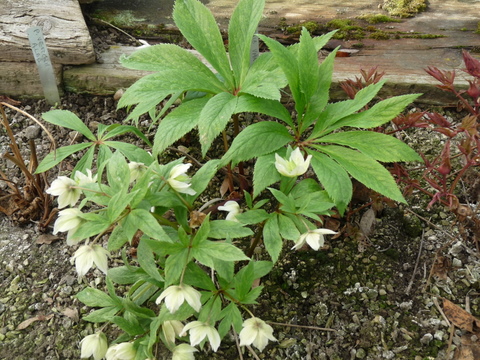
Helleborus torquatus - I think! One of the most variable species
in the genus
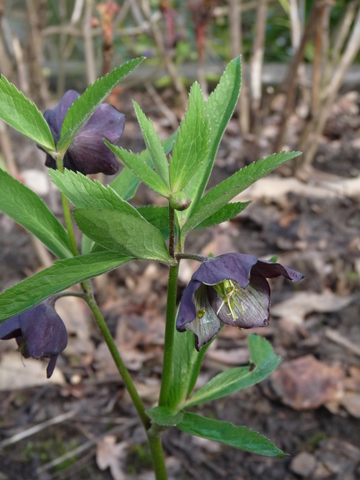
And finally back at Cilgwyn Lodge, a picture of magnolia
loebneri planted for our good friend Joy Stafford in memory of her
husband Len.
